DODGE GRAND CARAVAN 2004 Owners Manual
Manufacturer: DODGE, Model Year: 2004, Model line: GRAND CARAVAN, Model: DODGE GRAND CARAVAN 2004Pages: 397, PDF Size: 7.59 MB
Page 331 of 397
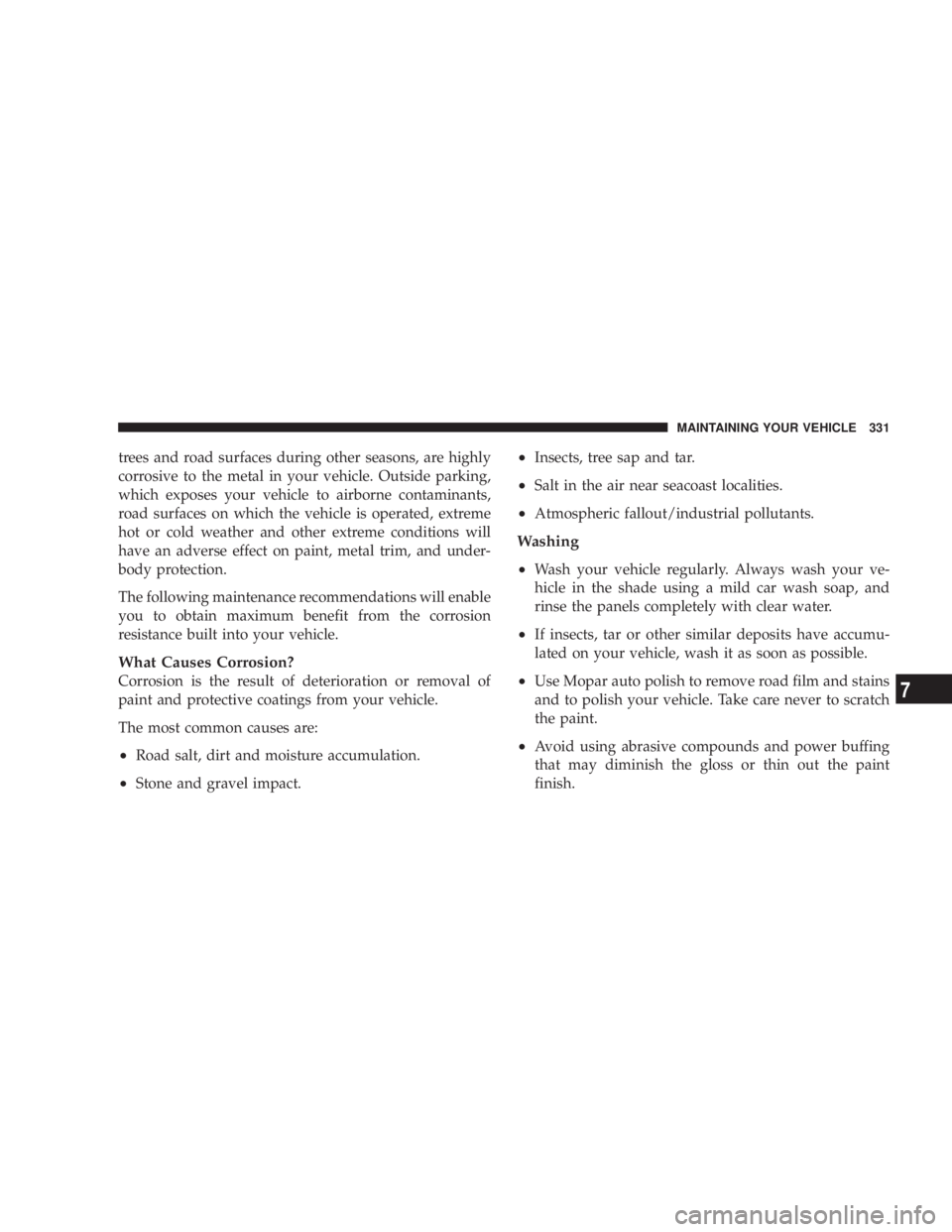
trees and road surfaces during other seasons, are highly
corrosive to the metal in your vehicle. Outside parking,
which exposes your vehicle to airborne contaminants,
road surfaces on which the vehicle is operated, extreme
hot or cold weather and other extreme conditions will
have an adverse effect on paint, metal trim, and under-
body protection.
The following maintenance recommendations will enable
you to obtain maximum benefit from the corrosion
resistance built into your vehicle.
What Causes Corrosion?
Corrosion is the result of deterioration or removal of
paint and protective coatings from your vehicle.
The most common causes are:
² Road salt, dirt and moisture accumulation.
² Stone and gravel impact. ² Insects, tree sap and tar.
² Salt in the air near seacoast localities.
² Atmospheric fallout/industrial pollutants.
Washing
² Wash your vehicle regularly. Always wash your ve-
hicle in the shade using a mild car wash soap, and
rinse the panels completely with clear water.
² If insects, tar or other similar deposits have accumu-
lated on your vehicle, wash it as soon as possible.
² Use Mopar auto polish to remove road film and stains
and to polish your vehicle. Take care never to scratch
the paint.
² Avoid using abrasive compounds and power buffing
that may diminish the gloss or thin out the paint
finish. MAINTAINING YOUR VEHICLE 331
7
Page 332 of 397
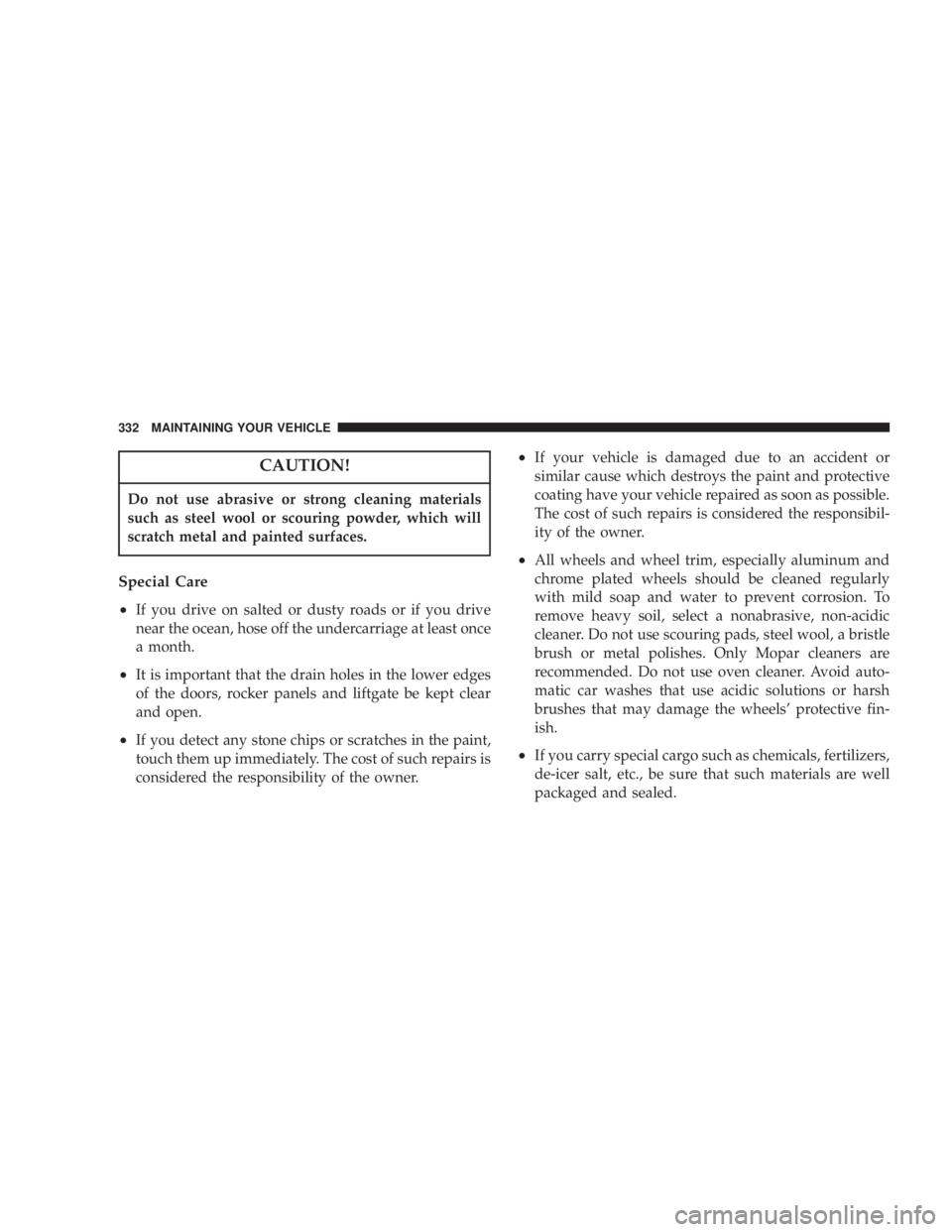
CAUTION!Do not use abrasive or strong cleaning materials
such as steel wool or scouring powder, which will
scratch metal and painted surfaces.
Special Care
²
If you drive on salted or dusty roads or if you drive
near the ocean, hose off the undercarriage at least once
a month.
² It is important that the drain holes in the lower edges
of the doors, rocker panels and liftgate be kept clear
and open.
² If you detect any stone chips or scratches in the paint,
touch them up immediately. The cost of such repairs is
considered the responsibility of the owner. ² If your vehicle is damaged due to an accident or
similar cause which destroys the paint and protective
coating have your vehicle repaired as soon as possible.
The cost of such repairs is considered the responsibil-
ity of the owner.
² All wheels and wheel trim, especially aluminum and
chrome plated wheels should be cleaned regularly
with mild soap and water to prevent corrosion. To
remove heavy soil, select a nonabrasive, non-acidic
cleaner. Do not use scouring pads, steel wool, a bristle
brush or metal polishes. Only Mopar cleaners are
recommended. Do not use oven cleaner. Avoid auto-
matic car washes that use acidic solutions or harsh
brushes that may damage the wheels' protective fin-
ish.
² If you carry special cargo such as chemicals, fertilizers,
de-icer salt, etc., be sure that such materials are well
packaged and sealed.332 MAINTAINING YOUR VEHICLE
Page 333 of 397
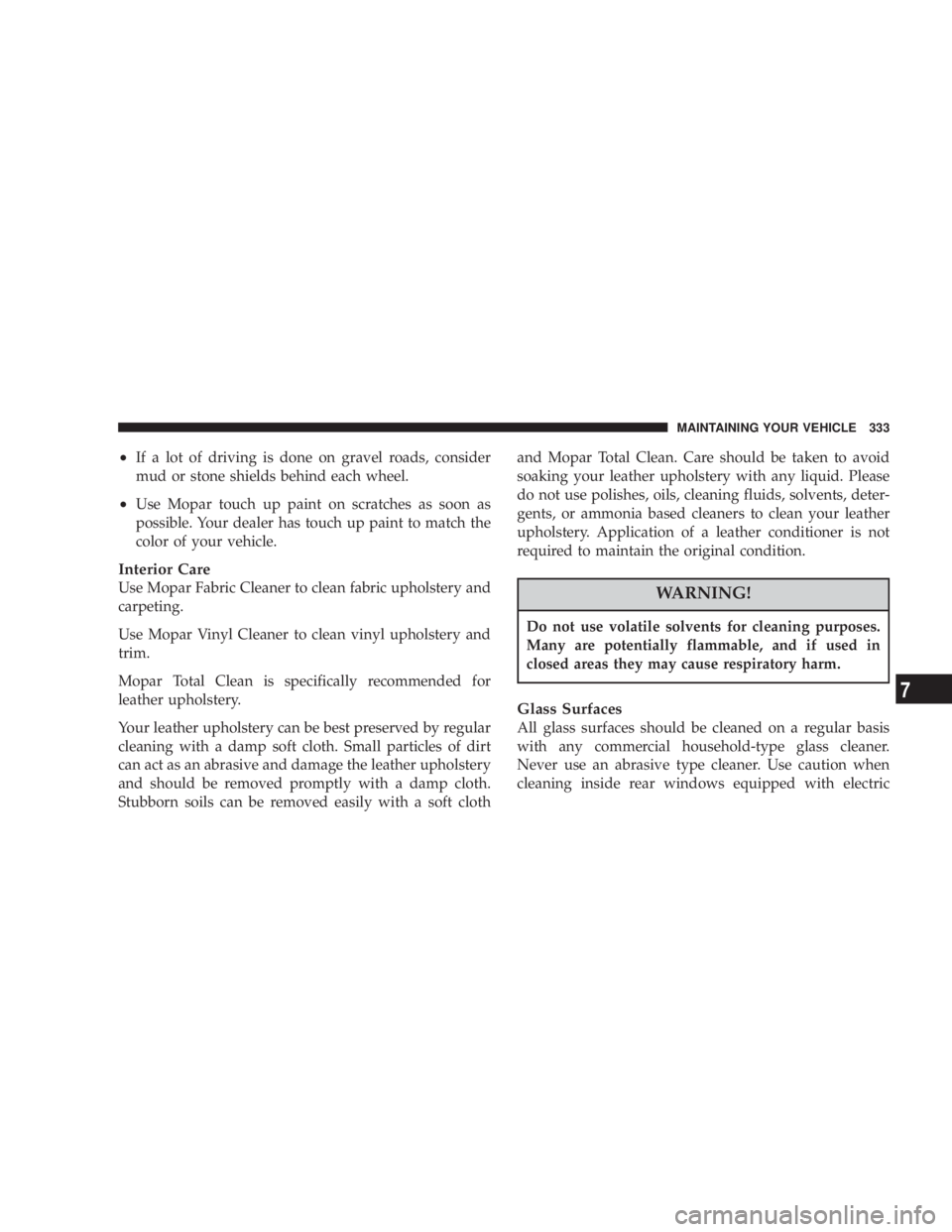
² If a lot of driving is done on gravel roads, consider
mud or stone shields behind each wheel.
² Use Mopar touch up paint on scratches as soon as
possible. Your dealer has touch up paint to match the
color of your vehicle.
Interior Care
Use Mopar Fabric Cleaner to clean fabric upholstery and
carpeting.
Use Mopar Vinyl Cleaner to clean vinyl upholstery and
trim.
Mopar Total Clean is specifically recommended for
leather upholstery.
Your leather upholstery can be best preserved by regular
cleaning with a damp soft cloth. Small particles of dirt
can act as an abrasive and damage the leather upholstery
and should be removed promptly with a damp cloth.
Stubborn soils can be removed easily with a soft cloth and Mopar Total Clean. Care should be taken to avoid
soaking your leather upholstery with any liquid. Please
do not use polishes, oils, cleaning fluids, solvents, deter-
gents, or ammonia based cleaners to clean your leather
upholstery. Application of a leather conditioner is not
required to maintain the original condition.
WARNING!Do not use volatile solvents for cleaning purposes.
Many are potentially flammable, and if used in
closed areas they may cause respiratory harm.
Glass Surfaces
All glass surfaces should be cleaned on a regular basis
with any commercial household-type glass cleaner.
Never use an abrasive type cleaner. Use caution when
cleaning inside rear windows equipped with electric MAINTAINING YOUR VEHICLE 333
7
Page 334 of 397
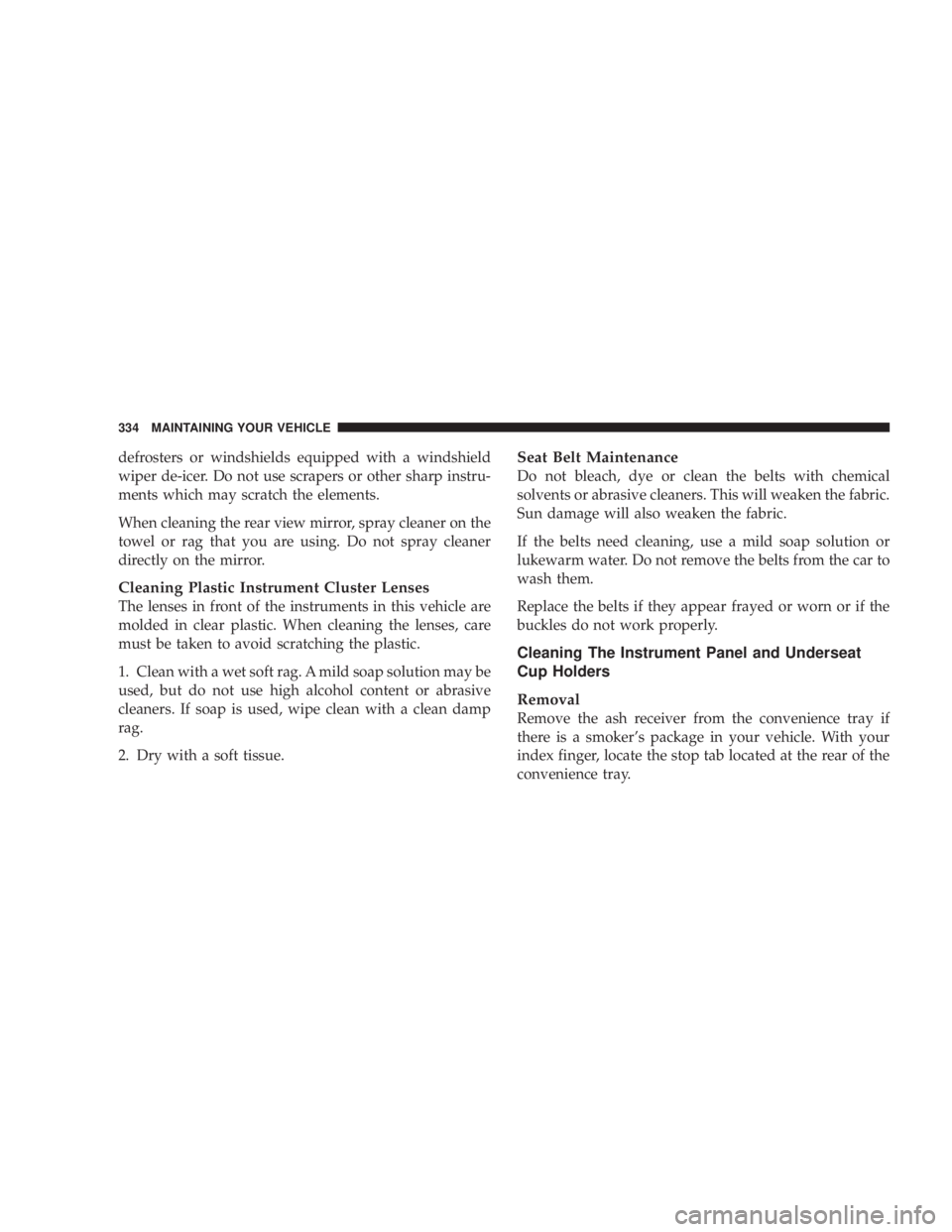
defrosters or windshields equipped with a windshield
wiper de-icer. Do not use scrapers or other sharp instru-
ments which may scratch the elements.
When cleaning the rear view mirror, spray cleaner on the
towel or rag that you are using. Do not spray cleaner
directly on the mirror.
Cleaning Plastic Instrument Cluster Lenses
The lenses in front of the instruments in this vehicle are
molded in clear plastic. When cleaning the lenses, care
must be taken to avoid scratching the plastic.
1. Clean with a wet soft rag. A mild soap solution may be
used, but do not use high alcohol content or abrasive
cleaners. If soap is used, wipe clean with a clean damp
rag.
2. Dry with a soft tissue. Seat Belt Maintenance
Do not bleach, dye or clean the belts with chemical
solvents or abrasive cleaners. This will weaken the fabric.
Sun damage will also weaken the fabric.
If the belts need cleaning, use a mild soap solution or
lukewarm water. Do not remove the belts from the car to
wash them.
Replace the belts if they appear frayed or worn or if the
buckles do not work properly.
Cleaning The Instrument Panel and Underseat
Cup Holders
Removal
Remove the ash receiver from the convenience tray if
there is a smoker's package in your vehicle. With your
index finger, locate the stop tab located at the rear of the
convenience tray.334 MAINTAINING YOUR VEHICLE
Page 335 of 397
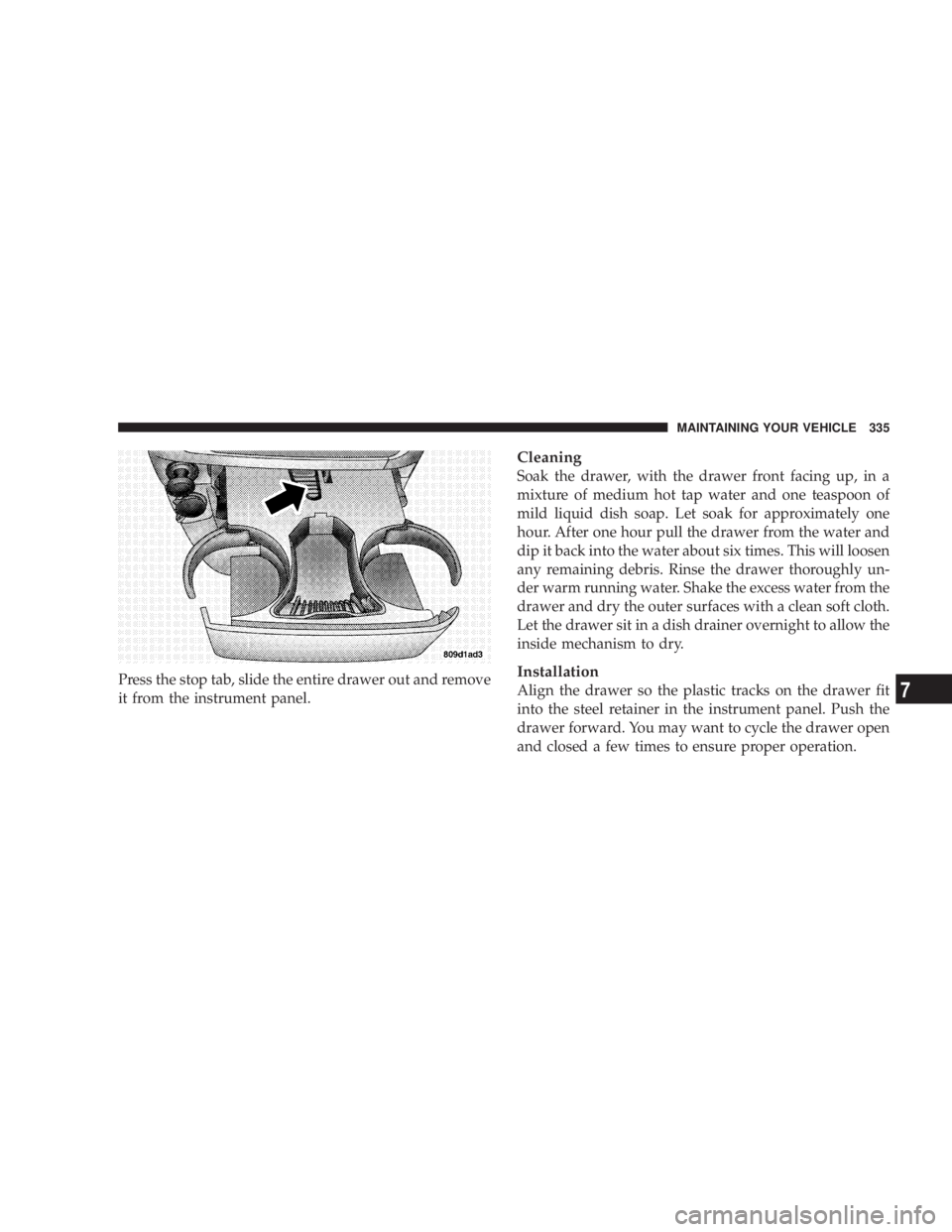
Press the stop tab, slide the entire drawer out and remove
it from the instrument panel. Cleaning
Soak the drawer, with the drawer front facing up, in a
mixture of medium hot tap water and one teaspoon of
mild liquid dish soap. Let soak for approximately one
hour. After one hour pull the drawer from the water and
dip it back into the water about six times. This will loosen
any remaining debris. Rinse the drawer thoroughly un-
der warm running water. Shake the excess water from the
drawer and dry the outer surfaces with a clean soft cloth.
Let the drawer sit in a dish drainer overnight to allow the
inside mechanism to dry.
Installation
Align the drawer so the plastic tracks on the drawer fit
into the steel retainer in the instrument panel. Push the
drawer forward. You may want to cycle the drawer open
and closed a few times to ensure proper operation. MAINTAINING YOUR VEHICLE 335
7
Page 336 of 397
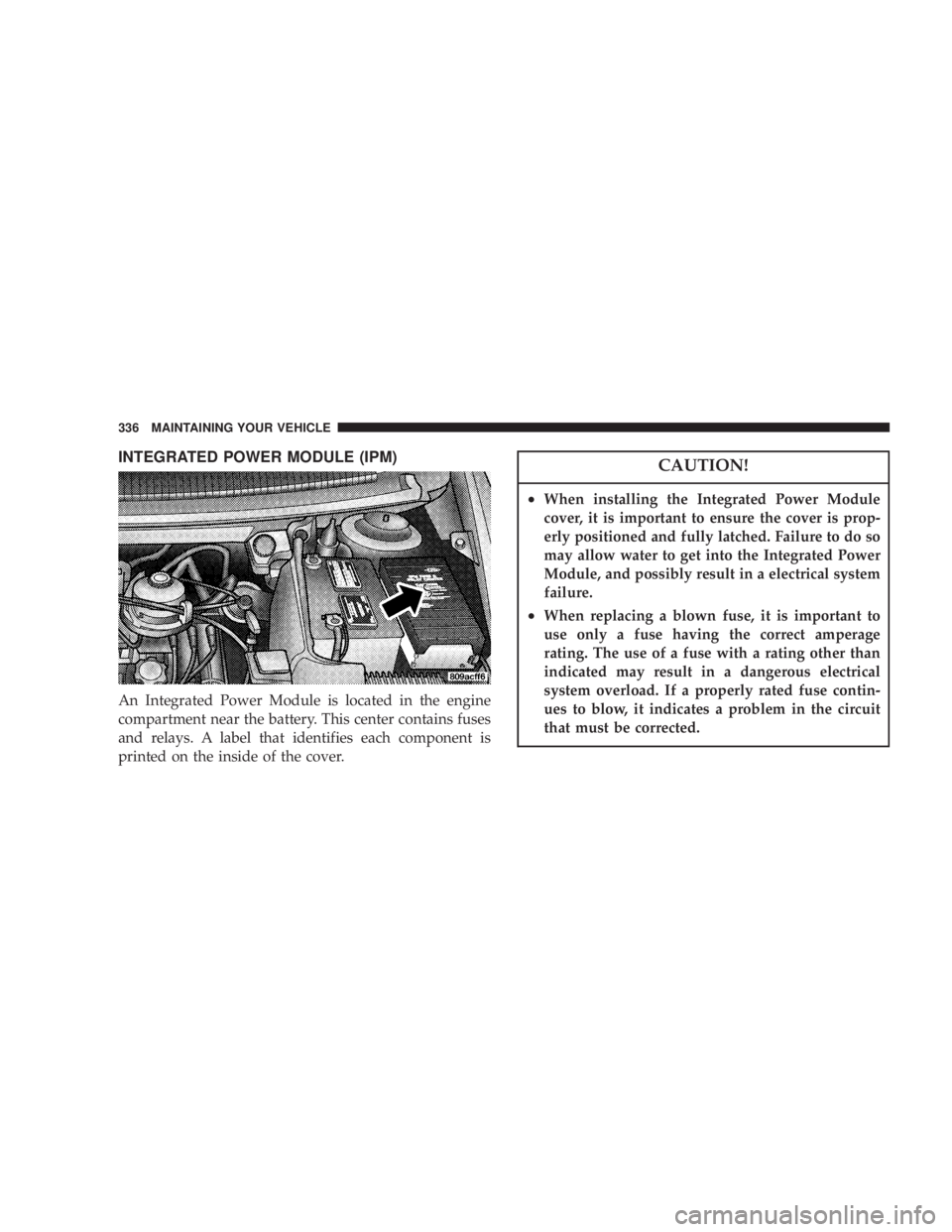
INTEGRATED POWER MODULE (IPM)
An Integrated Power Module is located in the engine
compartment near the battery. This center contains fuses
and relays. A label that identifies each component is
printed on the inside of the cover. CAUTION!² When installing the Integrated Power Module
cover, it is important to ensure the cover is prop-
erly positioned and fully latched. Failure to do so
may allow water to get into the Integrated Power
Module, and possibly result in a electrical system
failure.
² When replacing a blown fuse, it is important to
use only a fuse having the correct amperage
rating. The use of a fuse with a rating other than
indicated may result in a dangerous electrical
system overload. If a properly rated fuse contin-
ues to blow, it indicates a problem in the circuit
that must be corrected.336 MAINTAINING YOUR VEHICLE
Page 337 of 397
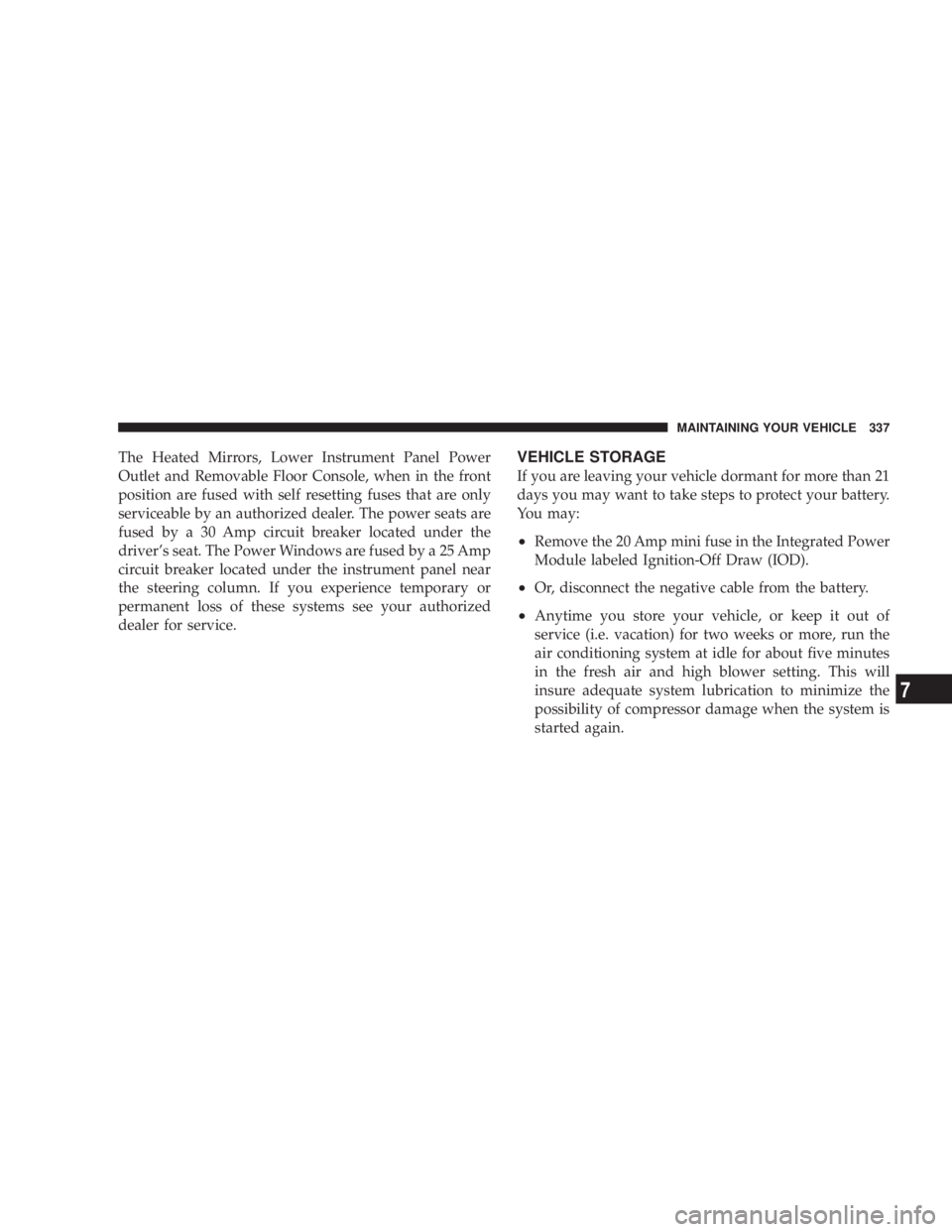
The Heated Mirrors, Lower Instrument Panel Power
Outlet and Removable Floor Console, when in the front
position are fused with self resetting fuses that are only
serviceable by an authorized dealer. The power seats are
fused by a 30 Amp circuit breaker located under the
driver's seat. The Power Windows are fused by a 25 Amp
circuit breaker located under the instrument panel near
the steering column. If you experience temporary or
permanent loss of these systems see your authorized
dealer for service. VEHICLE STORAGE
If you are leaving your vehicle dormant for more than 21
days you may want to take steps to protect your battery.
You may:
² Remove the 20 Amp mini fuse in the Integrated Power
Module labeled Ignition-Off Draw (IOD).
² Or, disconnect the negative cable from the battery.
² Anytime you store your vehicle, or keep it out of
service (i.e. vacation) for two weeks or more, run the
air conditioning system at idle for about five minutes
in the fresh air and high blower setting. This will
insure adequate system lubrication to minimize the
possibility of compressor damage when the system is
started again. MAINTAINING YOUR VEHICLE 337
7
Page 338 of 397
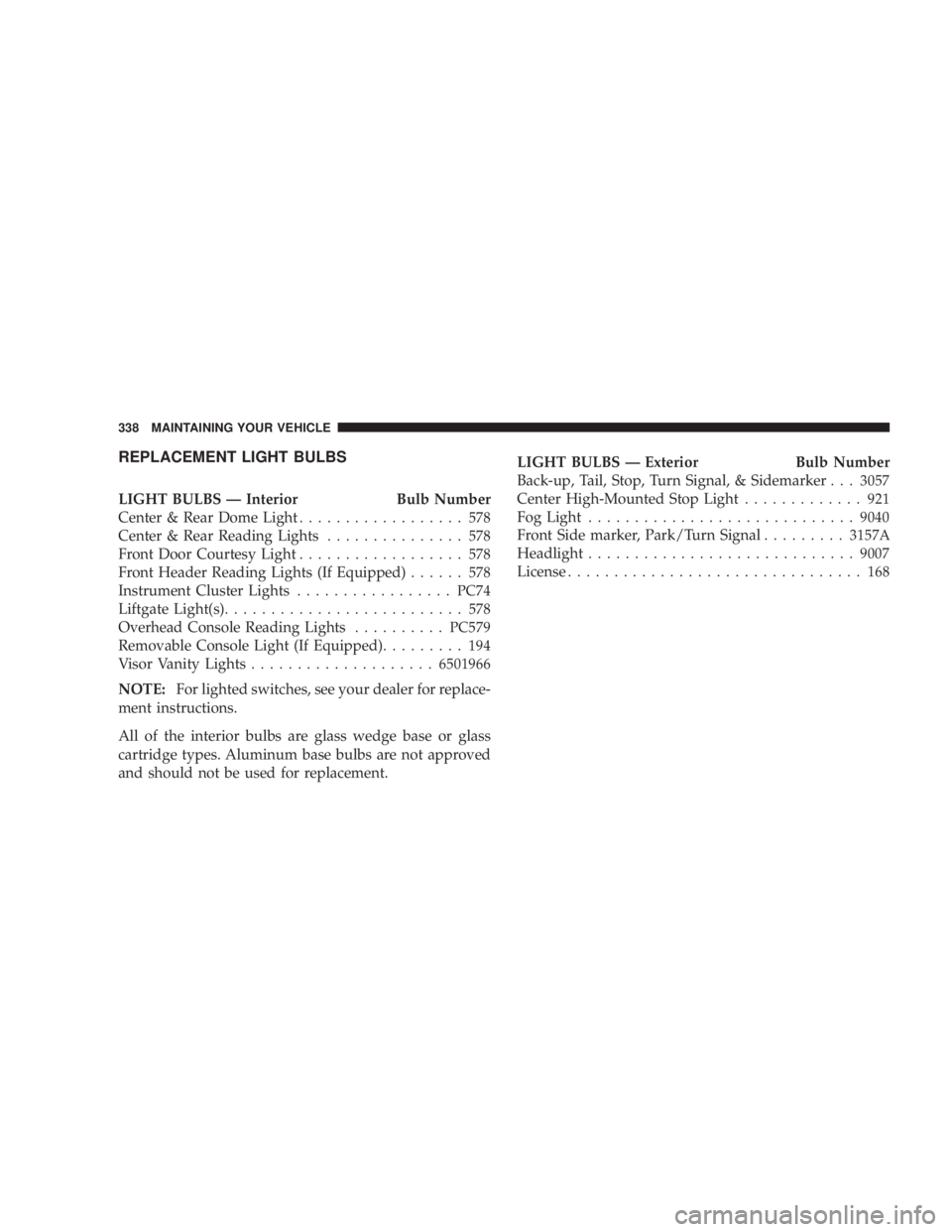
REPLACEMENT LIGHT BULBS
LIGHT BULBS Ð Interior Bulb Number
Center & Rear Dome Light .................. 578
Center & Rear Reading Lights ............... 578
Front Door Courtesy Light .................. 578
Front Header Reading Lights (If Equipped) ...... 578
Instrument Cluster Lights ................. PC74
Liftgate Light(s) .......................... 578
Overhead Console Reading Lights .......... PC579
Removable Console Light (If Equipped) ......... 194
Visor Vanity Lights .................... 6501966
NOTE: For lighted switches, see your dealer for replace-
ment instructions.
All of the interior bulbs are glass wedge base or glass
cartridge types. Aluminum base bulbs are not approved
and should not be used for replacement. LIGHT BULBS Ð Exterior Bulb Number
Back-up, Tail, Stop, Turn Signal, & Sidemarker . . . 3057
Center High-Mounted Stop Light ............. 921
Fog Light ............................. 9040
Front Side marker, Park/Turn Signal ......... 3157A
Headlight ............................. 9007
License ................................ 168338 MAINTAINING YOUR VEHICLE
Page 339 of 397
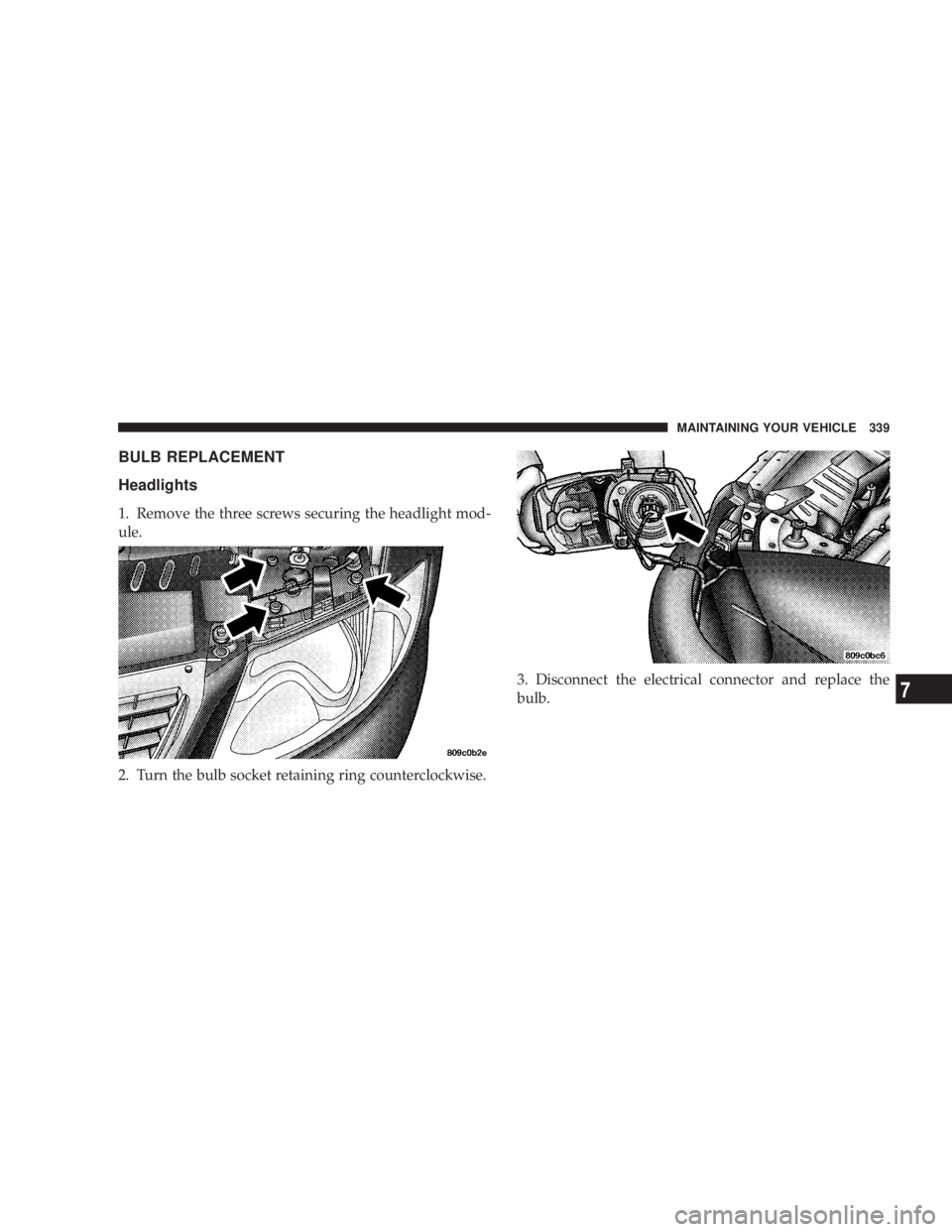
BULB REPLACEMENT
Headlights
1. Remove the three screws securing the headlight mod-
ule.
2. Turn the bulb socket retaining ring counterclockwise. 3. Disconnect the electrical connector and replace the
bulb. MAINTAINING YOUR VEHICLE 339
7
Page 340 of 397
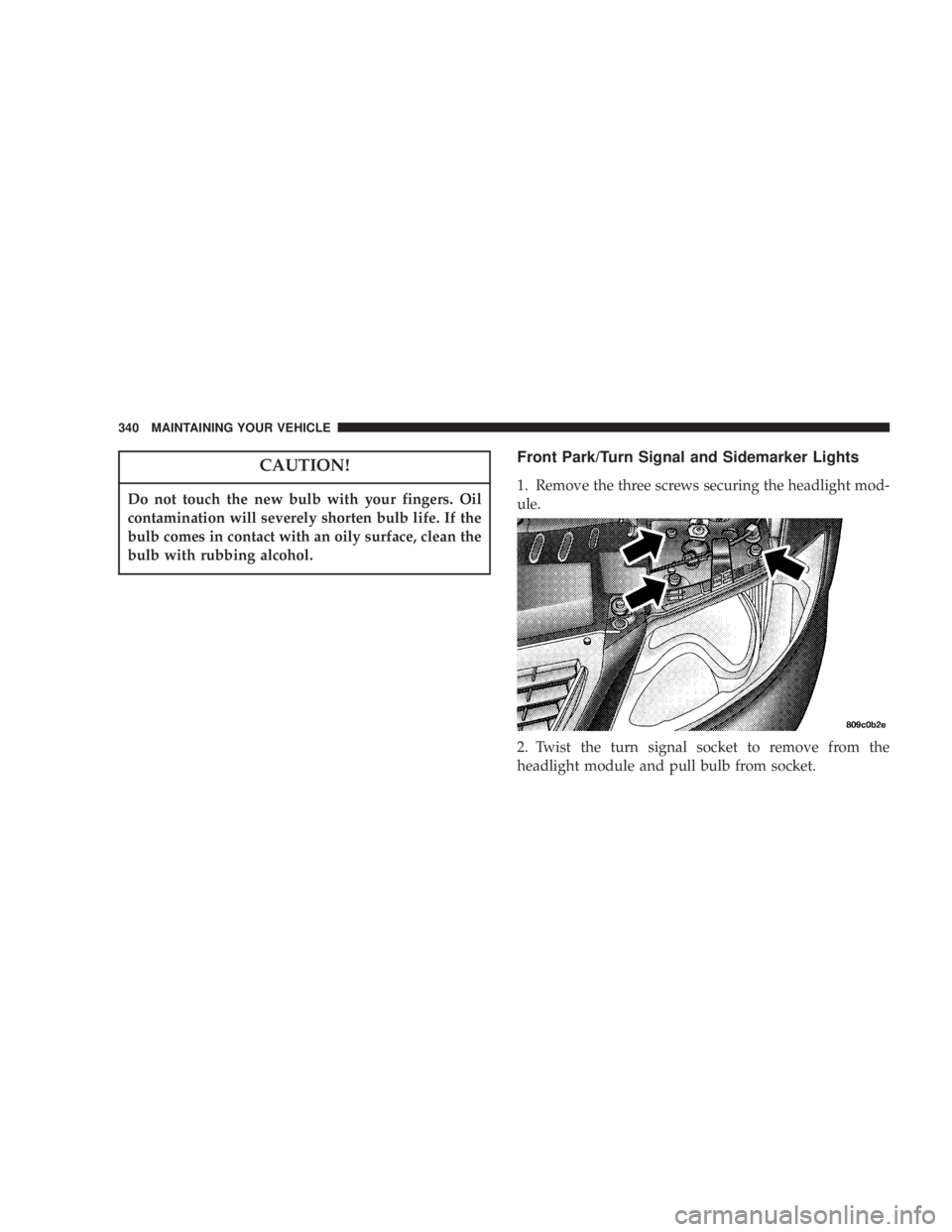
CAUTION!Do not touch the new bulb with your fingers. Oil
contamination will severely shorten bulb life. If the
bulb comes in contact with an oily surface, clean the
bulb with rubbing alcohol. Front Park/Turn Signal and Sidemarker Lights
1. Remove the three screws securing the headlight mod-
ule.
2. Twist the turn signal socket to remove from the
headlight module and pull bulb from socket.340 MAINTAINING YOUR VEHICLE